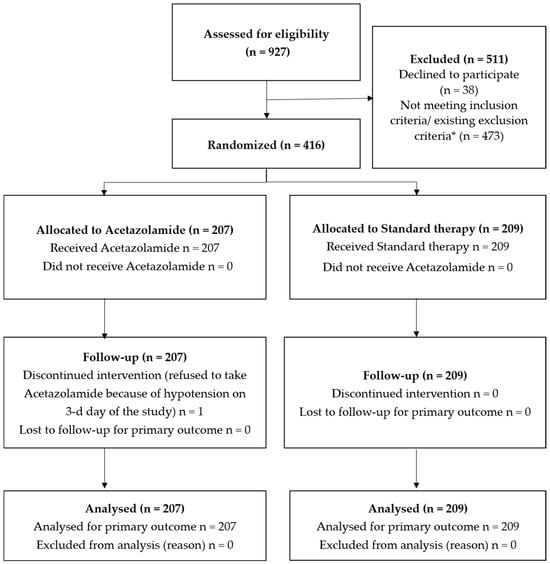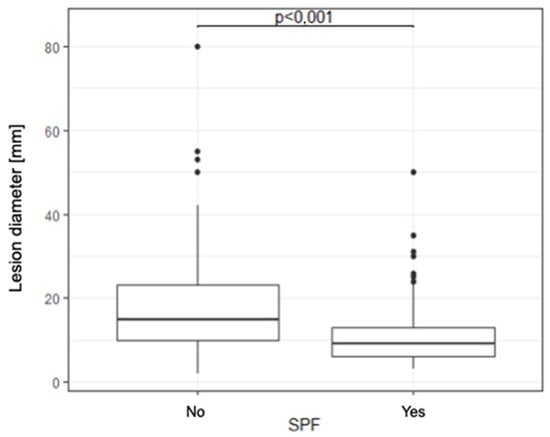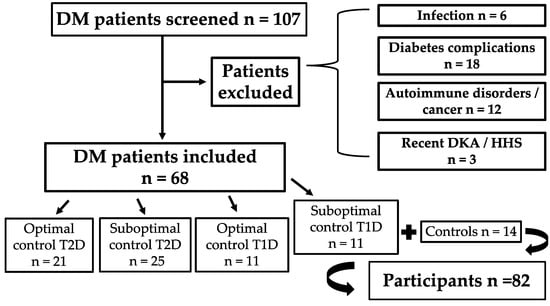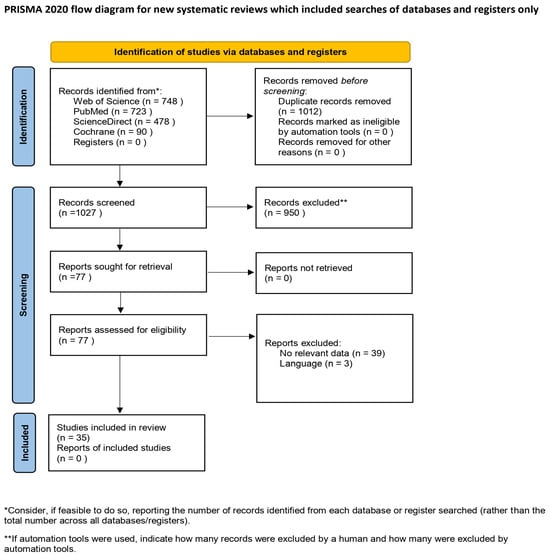-
 Investigation of the CTLA-4–CD28 Axis in Oral Squamous Cell Carcinoma
Investigation of the CTLA-4–CD28 Axis in Oral Squamous Cell Carcinoma -
 Now and the Future: Medications Changing the Landscape of Cardiovascular Disease and Heart Failure Management
Now and the Future: Medications Changing the Landscape of Cardiovascular Disease and Heart Failure Management -
 Clinical Efficacy and Real-World Effectiveness of Fabry Disease Treatments: A Systematic Literature Review
Clinical Efficacy and Real-World Effectiveness of Fabry Disease Treatments: A Systematic Literature Review -
 Immunosuppressants/Immunomodulators and Malignancy
Immunosuppressants/Immunomodulators and Malignancy -
 Clinical Management of Cerebral Amyloid Angiopathy
Clinical Management of Cerebral Amyloid Angiopathy
Journal Description
Journal of Clinical Medicine
Journal of Clinical Medicine
is an international, peer-reviewed, open access journal of clinical medicine, published semimonthly online by MDPI. The International Bone Research Association (IBRA), Spanish Society of Hematology and Hemotherapy (SEHH), Japan Association for Clinical Engineers (JACE), European Independent Foundation in Angiology/ Vascular Medicine (VAS) and others are all affiliated with JCM, and their members receive a discount on article processing charges.
- Open Access— free for readers, with article processing charges (APC) paid by authors or their institutions.
- High Visibility: indexed within Scopus, SCIE (Web of Science), PubMed, PMC, Embase, CAPlus / SciFinder, and other databases.
- Journal Rank: JCR - Q1 (Medicine, General and Internal) / CiteScore - Q1 (General Medicine)
- Rapid Publication: manuscripts are peer-reviewed and a first decision is provided to authors approximately 17.7 days after submission; acceptance to publication is undertaken in 2.7 days (median values for papers published in this journal in the first half of 2025).
- Recognition of Reviewers: reviewers who provide timely, thorough peer-review reports receive vouchers entitling them to a discount on the APC of their next publication in any MDPI journal, in appreciation of the work done.
- Companion journals for JCM include: Epidemiologia, Transplantology, Uro, Sinusitis, Rheumato, Journal of Clinical & Translational Ophthalmology, Journal of Vascular Diseases, Osteology, Complications, Therapeutics, Sclerosis, Pharmacoepidemiology and Journal of CardioRenal Medicine.
- Journal Clusters of Hematology: Hemato, Hematology Reports, Thalassemia Reports and Journal of Clinical Medicine.
Impact Factor:
2.9 (2024);
5-Year Impact Factor:
3.3 (2024)
Latest Articles
Case Series on the Combined Therapy with Elexacaftor/Tezacaftor/Ivacaftor During Pregnancy in Women with Severe Cystic Fibrosis: A Retrospective Report from an Italian Centre
J. Clin. Med. 2025, 14(18), 6520; https://doi.org/10.3390/jcm14186520 (registering DOI) - 16 Sep 2025
Abstract
In patients with cystic fibrosis (CF), infertility is a common issue in men, while women often experience subfertility. The introduction of CF transmembrane conductance regulator (CFTR) modulators has improved disease progression and enhanced quality of life, consequently leading to an increase in unplanned
[...] Read more.
In patients with cystic fibrosis (CF), infertility is a common issue in men, while women often experience subfertility. The introduction of CF transmembrane conductance regulator (CFTR) modulators has improved disease progression and enhanced quality of life, consequently leading to an increase in unplanned pregnancies. This article describes six cases of pregnancies in five patients diagnosed with severe CF who were treated with the combined therapy of elexacaftor/tezacaftor/ivacaftor (ETI). All women were under regular clinical and instrumental monitoring at the Regional CF Center for Adults at the University of Naples Federico II. The reported pregnancies were spontaneous, and all patients were followed throughout their pregnancies. Two pregnancies were carried to term by the same patient. All five patients with a severe CF phenotype were able to experience pregnancy without stopping their ETI treatment without any complications. In two cases, the patients chose to continue ETI therapy while breastfeeding, and there were no adverse events reported. A cesarean delivery was preferred in all cases to prevent potential respiratory distress. These five patients represent some of the few cases in Italy where pregnancy was achieved without interrupting treatment with ETI. However, the lack of more reliable data necessitates that doctors and patients carefully evaluate the risks and benefits of continuing or discontinuing treatment with CFTR modulators. In conclusion, the increasing number of pregnancies and the desire for children expressed by women with CF highlight the need for more data on the long-term effects of CFTR modulators.
Full article
(This article belongs to the Special Issue Idiopathic Pulmonary Fibrosis (IPF): Current Perspectives and Future Directions)
Open AccessReview
Augmented Decisions: AI-Enhanced Accuracy in Glaucoma Diagnosis and Treatment
by
Marco Zeppieri, Caterina Gagliano, Daniele Tognetto, Mutali Musa, Alessandro Avitabile, Fabiana D’Esposito, Simonetta Gaia Nicolosi and Matteo Capobianco
J. Clin. Med. 2025, 14(18), 6519; https://doi.org/10.3390/jcm14186519 (registering DOI) - 16 Sep 2025
Abstract
Glaucoma remains a leading cause of irreversible blindness. We reviewed more than 150 peer-reviewed studies (January 2019–July 2025) that applied artificial or augmented intelligence (AI/AuI) to glaucoma care. Deep learning systems analyzing fundus photographs or OCT volumes routinely achieved area-under-the-curve values around 0.95
[...] Read more.
Glaucoma remains a leading cause of irreversible blindness. We reviewed more than 150 peer-reviewed studies (January 2019–July 2025) that applied artificial or augmented intelligence (AI/AuI) to glaucoma care. Deep learning systems analyzing fundus photographs or OCT volumes routinely achieved area-under-the-curve values around 0.95 and matched—or exceeded—subspecialists in prospective tests. Sequence-aware models detected visual field worsening up to 1.7 years earlier than conventional linear trends, while a baseline multimodal network integrating OCT, visual field, and clinical data predicted the need for incisional surgery with AUROC 0.92. Offline smartphone triage in community clinics reached sensitivities near 94% and specificities between 86% and 94%, illustrating feasibility in low-resource settings. Large language models answered glaucoma case questions with specialist-level accuracy but still require human oversight. Key obstacles include algorithmic bias, workflow integration, and compliance with emerging regulations, such as the EU AI Act and FDA GMLP. With rigorous validation, bias auditing, and transparent change control, AI/AuI can augment—rather than replace—clinician expertise, enabling earlier intervention, tailored therapy, and more equitable access to glaucoma care worldwide.
Full article
(This article belongs to the Special Issue Augmented and Artificial Intelligence in Ophthalmology)
Open AccessArticle
Bidirectional Neoadjuvant Chemotherapy for Patients with Gastric Cancer and Synchronous Peritoneal Metastases (GCPMs): Results of a Western Phase II Study
by
Daniele Biacchi, Marco Angrisani, Vincenzo Picone, Daniele Scuto, Maria Gloria Gallotti, Fabio Accarpio, Franco Iafrate, Giorgio Masci, Immacolata Iannone, Alessandra Spagnoli and Paolo Sammartino
J. Clin. Med. 2025, 14(18), 6518; https://doi.org/10.3390/jcm14186518 - 16 Sep 2025
Abstract
Background: The outcomes of patients with peritoneal metastases from gastric cancer (GCPMs) remain dismal, with an overall survival (OS) of less than 1 year. Approaches reported from East Asia include normothermic intraperitoneal systemic chemotherapy, aimed at downstaging the disease, allowing an R0 resection.
[...] Read more.
Background: The outcomes of patients with peritoneal metastases from gastric cancer (GCPMs) remain dismal, with an overall survival (OS) of less than 1 year. Approaches reported from East Asia include normothermic intraperitoneal systemic chemotherapy, aimed at downstaging the disease, allowing an R0 resection. This is the first Western study evaluating a bidirectional regimen in a neoadjuvant setting of GCPMs. This phase II study evaluates the tolerability, efficacy and conversion surgery rate. Methods: Patients with PCI < 13 without ascites or HER2 overexpression and no extraperitoneal spread were enrolled starting in January 2018. After staging laparoscopy combined with PIPAC (cisplatin + doxorubicin), NIPS began following Yonemura’s schedule: cisplatin (30 mg/m2) + docetaxel (30 mg/m2), intraperitoneally (day 1); capecitabine 1000 mg/m2, orally (days 2–15); and cisplatin (30 mg/m2) + docetaxel (30 mg/m2), intravenous (day 8). After three cycles, patients with no progressive disease and negative peritoneal cytology underwent cytoreductive surgery (CRS) combined with hyperthermic intraperitoneal chemotherapy (HIPEC). Three additional NIPS cycles were reserved for patients who underwent surgery. Results: Among the 25 treated patients with 17.3-month (95%CI: 10.4; NA) OS, no adverse events (CTCAE) ≥ G3 arose. With a 52% conversion surgery rate, 13 patients underwent CRS combined with HIPEC (cisplatin 100 mg/m2), 10 with CC0 status 3 with CC experienced no operative mortality, and major complications rated Clavien–Dindo IIIB occurred in 2 patients (15.4%). The median OS for patients undergoing surgery was 26 (95%CI: 23.1; NA) months, with progression-free survival of 20 (95%CI: 16.7–NA) months. Conclusions: NIPS is safe and effective. The conversion rate in our Western patients is comparable to that reported in Eastern Asian countries.
Full article
(This article belongs to the Special Issue Advances in Gastric Cancer and Peritoneal Diseases)
Open AccessArticle
Acetazolamide per os in Decompensated Chronic Heart Failure: Randomized Multicenter Trial ORION-A
by
Ibragim Sabirov, Olesya Rubanenko, Svetlana Villevalde, Anatoly Rubanenko, Nadezhda Veselovskaya, Vitaly Ivanenko, Natalia Kosheleva, Maksim Menzorov, Ilya Pochinka, Konstantin Protasov, Niyaz Khasanov, Sergey Yakushin, Elena Medvedeva and Dmitry Duplyakov
J. Clin. Med. 2025, 14(18), 6517; https://doi.org/10.3390/jcm14186517 - 16 Sep 2025
Abstract
Background/Objectives: Overcoming resistance to diuretics is extremely important in decompensated chronic heart failure (HF). The objective of this study was to assess the efficacy and safety of oral acetazolamide, in addition to standard therapy, in HF patients admitted to the hospital with
[...] Read more.
Background/Objectives: Overcoming resistance to diuretics is extremely important in decompensated chronic heart failure (HF). The objective of this study was to assess the efficacy and safety of oral acetazolamide, in addition to standard therapy, in HF patients admitted to the hospital with decompensation requiring intravenous loop diuretic therapy. Methods: In this open-label, prospective, multicenter, randomized trial, we included 416 patients hospitalized with decompensated HF. The patients were randomized into two groups: (1) standard therapy, and (2) standard therapy + acetazolamide orally 250 mg 3 times a day in the first 3 days of hospitalization. At randomization, oral thiazide/thiazide-like and loop diuretics were stopped, and intravenous furosemide was initiated. Results: Successful decongestion within 72 h of randomization was observed in 82 patients (39.6%) in the acetazolamide group and in 83 patients (39.7%) in the standard therapy group (p = 0.983). There was a significant difference in the increase in diuresis in the first 72 h (p = 0.028) and in natriuresis on the 2nd day (p = 0.04). There were no differences between the groups in duration of stay in the intensive care unit, duration of index hospitalization, 6 min walk test distance, and clinical assessment scale scores. Death from any cause occurred in three (1.4%) patients in the acetazolamide group, and in the same number of patients in the standard therapy group (p = 0.996). Death from cardiovascular cause and due to decompensated HF also did not differ between the groups during follow-up. Conclusions: The addition of acetazolamide to standard therapy in decompensated chronic HF resulted in a higher cumulative urine output during the first 72 h and natriuresis on the 2nd day after randomization.
Full article
(This article belongs to the Special Issue Clinical Challenges in Heart Failure Management)
►▼
Show Figures

Figure 1
Open AccessArticle
Expiratory Flow Bias and Physiological Effects of Rapid Chest Compression in Mechanically Ventilated Neurocritical Patients: A Secondary Analysis of a Randomized Controlled Trial
by
Ricardo Miguel Rodrigues-Gomes, Rosa Martinez Rolán, Maribel Botana-Rial, Alejandra Del Río González and Eduardo Arán-Echabe
J. Clin. Med. 2025, 14(18), 6516; https://doi.org/10.3390/jcm14186516 - 16 Sep 2025
Abstract
Background: Mechanical ventilation compromises airway clearance, with expiratory flow bias (EFB) being a critical determinant of mucus transport. The rapid chest compression technique (RCCT) generates high EFB, yet evidence in neurocritical patients is limited due to concerns regarding intracranial pressure (ICP). This secondary
[...] Read more.
Background: Mechanical ventilation compromises airway clearance, with expiratory flow bias (EFB) being a critical determinant of mucus transport. The rapid chest compression technique (RCCT) generates high EFB, yet evidence in neurocritical patients is limited due to concerns regarding intracranial pressure (ICP). This secondary analysis of a randomized controlled trial examined the effects of RCCT on ventilatory mechanics and physiology in acute brain-injured patients under invasive ventilation. Methods: Fifty neurocritical patients were randomized to RCCT (Intervention) or passive leg mobilization (Control). RCCT was applied bilaterally during expiration once every three respiratory cycles for 5 min; controls underwent 5 min of passive cycling. EFB, derived from inspiratory and expiratory peak flows, was assessed at baseline (T–5), during intervention (T0–T5), and post-intervention (T+5, T+30). Arterial blood gases, mean arterial pressure (MAP), heart rate (HR), and ICP were also analyzed. Group comparisons used parametric/non-parametric tests; associations were explored via Spearman’s rho. Results: Baseline EFB did not differ between groups. From T0 to T5, Intervention patients showed significantly higher EFB (all p < 0.001). PaCO2 decreased within the Intervention group (p = 0.015) but not in controls (p = 0.601). No between-group ΔPaCO2 differences emerged. At T5, HR correlated negatively with EFB (ρ = −0.49, p = 0.013). No associations were found with age, sex, lesion type, MAP, or ICP. Conclusions: RCCT effectively increased EFB in ventilated neurocritical patients without affecting ICP, supporting its safety and potential role in airway clearance.
Full article
(This article belongs to the Section Respiratory Medicine)
►▼
Show Figures

Figure 1
Open AccessArticle
Differential Effects of Corneal Biomechanics on Superficial and Deep Vessel Density and Their Association with Central Visual Function in Glaucoma Patients with Myopia
by
Kyoung Ohn, Younhea Jung and Hae-Young Lopilly Park
J. Clin. Med. 2025, 14(18), 6515; https://doi.org/10.3390/jcm14186515 - 16 Sep 2025
Abstract
Background/Objectives: The purpose of this study was to investigate corneal biomechanical properties assessed with Corvis ST, structural features of myopia, and vessel density (VD) measured by optical coherence tomography angiography (OCT-A) and their associations with central visual function in myopic glaucoma patients. Methods:
[...] Read more.
Background/Objectives: The purpose of this study was to investigate corneal biomechanical properties assessed with Corvis ST, structural features of myopia, and vessel density (VD) measured by optical coherence tomography angiography (OCT-A) and their associations with central visual function in myopic glaucoma patients. Methods: Forty-two eyes of 42 glaucoma patients with myopia without retinal lesions were subjected to analysis. Corvis ST was performed to measure the biomechanical properties of the eyeball. Superficial (retinal) and deep (choroidal) VDs in the peripapillary and macular regions were assessed using OCT-A, and retinal nerve fiber layer (RNFL) thickness was measured with OCT. The disc–foveal angle, disc torsion, and β-zone peripapillary atrophy (PPA) area were obtained from disc and retinal photography. Swedish interactive thresholding algorithm (SITA) 24-2 visual field (VF) testing was used to evaluate the function within the central 12 points. Results: A worse mean deviation (MD) from SITA 24-2 and higher whole-eye movement maximum from Corvis ST, representing deformable corneas, were associated with lower superficial peripapillary VD. A lower A1 deflection amplitude from Corvis ST, representing stiffer corneas, was associated with lower deep peripapillary VD. The sensitivity of the central 12 VF points was significantly associated with a larger disc–foveal angle, lower superficial peripapillary VD, and lower HC deformation amplitude from Corvis ST. Conclusion: Our preliminary findings suggest that more compliant corneas were associated with lower superficial VD, whereas stiffer corneas were associated with lower deep VD and central scotoma.
Full article
(This article belongs to the Section Ophthalmology)
Open AccessArticle
Long COVID and Acute Stroke in the Emergency Department: An Analysis of Presentation, Reperfusion Treatment, and Early Outcomes
by
Daian-Ionel Popa, Florina Buleu, Aida Iancu, Anca Tudor, Carmen Gabriela Williams, Marius Militaru, Codrina Mihaela Levai, Tiberiu Buleu, Livia Ciolac, Anda Gabriela Militaru and Ovidiu Alexandru Mederle
J. Clin. Med. 2025, 14(18), 6514; https://doi.org/10.3390/jcm14186514 - 16 Sep 2025
Abstract
Background and Objectives: Long COVID has been linked with persistent neurological symptoms, but data on its effects on acute stroke presentation, management, and outcomes remain unclear. This study aimed to compare the clinical profile, management, and short-term outcome of acute ischemic stroke patients
[...] Read more.
Background and Objectives: Long COVID has been linked with persistent neurological symptoms, but data on its effects on acute stroke presentation, management, and outcomes remain unclear. This study aimed to compare the clinical profile, management, and short-term outcome of acute ischemic stroke patients with and without Long COVID. Materials and Methods: A retrospective cohort study was conducted on 132 patients who presented at admission with code stroke alert in our Emergency Department (ED). Out of those, 26 were identified to have the Long COVID condition and assigned to the Long COVID group, and 106 were without the Long COVID condition and assigned to the No Long COVID group. Baseline demographics, stroke severity by NIHSS (National Institutes of Health Stroke Scale), risk factors, admission symptoms, laboratory findings, Emergency department time targets, reperfusion treatments received, and outcomes between the two groups were compared. Results: There were no significant differences between the two groups in age, gender, baseline NIHSS scores, ED time targets, or laboratory values. The proportion of patients with Long COVID significantly increased among non-smokers (Fisher’s Exact Test chi-squared, p = 0.027). Also, patients suffering from Long COVID exhibited higher incidences of headache (19.2% compared to 5.7%, OR = 3.97, p = 0.040) and facial drooping (42.3% compared to 19.8%, OR = 2.97, p = 0.022). The mechanical thrombectomy was more frequent among the group with Long COVID (30.8% vs. 16.0%), but this difference was not statistically significant. More hemorrhagic transformations happened in the Long COVID group (26.9% vs. 14.2%, p = 0.143). Discharge rates and hospital length of stay in days were similar between groups. Conclusions: Long COVID patients did not present notable differences in emergency department time targets, baseline stroke severity, or short-term outcomes when presenting with code stroke alert. Nevertheless, specific clinical characteristics—such as elevated occurrences of headache and facial drooping—were more frequently observed in patients with Long COVID, alongside non-significant trends indicating a greater utilization of mechanical thrombectomy and increased rates of hemorrhagic transformation. These results imply that Long COVID may have a subtle impact on stroke presentation and potentially on underlying cerebrovascular susceptibility. Further prospective studies with larger sample sizes are necessary to investigate Long COVID’s long-term neurological and vascular consequences.
Full article
(This article belongs to the Special Issue Sequelae of COVID-19: Clinical to Prognostic Follow-Up)
Open AccessReview
Exploring Applications of Transcranial Magnetic Stimulation in Child and Adolescent Psychiatry: A Narrative Review
by
Omar El-Shahawy, Mona Salehi, Mahdieh Saeidi, Sanobar Jaka, Julia Lopez, Pegah Yakhchalian, Mohsen Abbasi-Kangevari and Sasidhar Gunturu
J. Clin. Med. 2025, 14(18), 6513; https://doi.org/10.3390/jcm14186513 - 16 Sep 2025
Abstract
Background: Transcranial magnetic stimulation (TMS) is an emerging noninvasive treatment modality for various psychiatric disorders, but its applications in child and adolescent populations remain underexplored. This review aims to synthesize current evidence on the therapeutic potential of TMS in treating psychiatric conditions
[...] Read more.
Background: Transcranial magnetic stimulation (TMS) is an emerging noninvasive treatment modality for various psychiatric disorders, but its applications in child and adolescent populations remain underexplored. This review aims to synthesize current evidence on the therapeutic potential of TMS in treating psychiatric conditions within this demographic. Methods: A comprehensive literature search was performed using PubMed and Google Scholar databases to identify studies published up to March 2025 that reported on the use of transcranial TMS in child and adolescent psychiatric disorders. Results: We found 32 published studies that included at least one type of TMS. TMS demonstrates potential as a safe and effective intervention for conditions such as depression, autism spectrum disorder, attention-deficit/hyperactivity disorder, obsessive–compulsive disorder, Tourette Syndrome, and childhood schizophrenia. However, the therapeutic outcomes vary significantly across conditions and protocols. Conclusions: TMS offers a promising, well-tolerated option for addressing psychiatric disorders in children and adolescents, but its application requires careful ethical and clinical consideration. To fully realize its potential, future research should focus on refining protocols, standardizing methodologies, and ensuring safety while expanding its use across diverse psychiatric conditions in younger populations.
Full article
(This article belongs to the Special Issue Mood Disorders: Diagnosis, Management and Future Opportunities)
Open AccessArticle
Awareness, Prevention, and Risk Factors of Non-Pigmented Skin Cancers: A Cross-Sectional Study Among Patients Undergoing Surgical Treatment
by
Monika Wojarska, Paulina Bernecka and Jerzy Jankau
J. Clin. Med. 2025, 14(18), 6512; https://doi.org/10.3390/jcm14186512 - 16 Sep 2025
Abstract
Background/Objectives: Skin cancer is the most common cancer worldwide, creating a significant burden on healthcare systems. According to the World Health Organization, 1.5 million new cases are reported annually, though the actual number is likely higher due to underreporting. The main risk
[...] Read more.
Background/Objectives: Skin cancer is the most common cancer worldwide, creating a significant burden on healthcare systems. According to the World Health Organization, 1.5 million new cases are reported annually, though the actual number is likely higher due to underreporting. The main risk factor is UV radiation, with additional contributors such as smoking, older age, and outdoor work. Basal cell carcinoma (70–80%) and squamous cell carcinoma are the most prevalent non-pigmented skin cancers. This study assessed the knowledge of patients undergoing surgical treatment for facial skin cancer regarding risk factors, prevention, treatment, and health-related behaviors. The goal was to guide educational strategies aimed at reducing disease incidence and improving outcomes. Methods: A cross-sectional study of 220 patients treated at the UCK Department of Plastic Surgery (April–August 2024) was conducted. Participants completed anonymous questionnaires on demographics, medical history, beliefs about lesions, and sun-protective behaviors. Clinical data included tumor location, size, histopathology, and excision completeness. Statistical significance was set at p < 0.05. Results: Patients were on average 71 years old; 61% had a secondary education. Sun protection habits varied by education and gender. SPF use was higher among those with higher education (79.55%) and among women (55.83%). SPF users had smaller lesion diameters (p < 0.001). However, 71% delayed seeking care for over a year, often due to misperceptions. Conclusions: There is a notable lack of awareness about skin cancer, especially prevention and early detection. Education and gender influence protective behaviors. Tailored educational initiatives may help reduce incidence and promote earlier diagnosis.
Full article
(This article belongs to the Special Issue Skin Cancer: Prevention, Diagnosis and Treatment)
►▼
Show Figures

Figure 1
Open AccessArticle
Interleukin-6-Related Inflammatory Burden in Type 1 Diabetes: Evidence for Elevation with Suboptimal Glycemic Control
by
Theocharis Koufakis, Dimitrios Kouroupis, Areti Kourti, Katerina Thisiadou, Paraskevi Karalazou, Djordje S. Popovic, Dimitrios Patoulias, Giuseppe Maltese, Athina Pyrpasopoulou, Panagiotis Doukelis, Ioanna Zografou, Kalliopi Kotsa, Michael Doumas and Kali Makedou
J. Clin. Med. 2025, 14(18), 6511; https://doi.org/10.3390/jcm14186511 - 16 Sep 2025
Abstract
Background/Objectives: Inflammation is a hallmark of diabetes, with interleukin-6 (IL-6) emerging as a key mediator linking immune activation with metabolic regulation. Although IL-6 has been studied in both type 1 (T1D) and type 2 diabetes (T2D), its relationship with glycemic control across
[...] Read more.
Background/Objectives: Inflammation is a hallmark of diabetes, with interleukin-6 (IL-6) emerging as a key mediator linking immune activation with metabolic regulation. Although IL-6 has been studied in both type 1 (T1D) and type 2 diabetes (T2D), its relationship with glycemic control across diabetes subtypes remains unexplored. Methods: We conducted a cross-sectional pilot study including 82 participants divided into the following subgroups: healthy controls (n = 14), individuals with T1D [n = 11 with glycated hemoglobin (HbA1c) < 7%; n = 11 with HbA1c ≥ 7%] and T2D (n = 21 with HbA1c < 7%; n = 25 with HbA1c ≥ 7%). Demographic, anthropometric, and laboratory parameters were collected. Group comparisons were performed, adjusted for age and body mass index (BMI) to account for significant demographic differences between groups. Correlations between IL-6, high-sensitivity C-reactive protein (hs-CRP), ferritin, and presepsin were evaluated using Spearman’s rank correlation. Results: IL-6 levels were approximately four-fold higher in T1D individuals with HbA1c ≥ 7% compared with controls [fold-change 4.06 (95% CI: 1.36–12.1), p = 0.013], with optimally managed T1D showing a non-significant trend (p = 0.079). No significant differences were observed in T2D groups. Advancing age demonstrated a borderline association with IL-6 (p = 0.068), whereas BMI was not significantly related. IL-6 correlated positively with hs-CRP (ρ = 0.463, p < 0.001), but not with ferritin or presepsin. Conclusions: IL-6 concentrations were significantly elevated in individuals with suboptimally managed T1D compared with controls, independent of age and BMI, suggesting that poor metabolic control amplifies systemic inflammation in autoimmune diabetes. These findings support IL-6 as a biomarker of inflammatory burden in T1D and provide a rationale for larger, longitudinal studies to determine its clinical utility.
Full article
(This article belongs to the Special Issue Autoimmune Diseases and Multisystem Inflammation: Pathophysiology and Therapeutic Strategies)
►▼
Show Figures

Figure 1
Open AccessSystematic Review
Technical Variations in Lateral Extra-Articular Tenodesis for Anterior Cruciate Ligament Reconstruction: A Systematic Review
by
Jan Zabrzyński, Bartosz Turoń, Adam Kwapisz, Achilles Boutsiadis, Maria Zabrzyńska, Maciej Sokołowski, Bartosz Majchrzak, Michalina Adamczyk, Katie Kellett and Gazi Huri
J. Clin. Med. 2025, 14(18), 6510; https://doi.org/10.3390/jcm14186510 - 16 Sep 2025
Abstract
Background/Objectives: The aim was to provide a comprehensive, systematic review on the Lateral Extra-articular Tenodesis (LET) methods used in anterior cruciate ligament (ACL) reconstruction in the light of recent data. Methods: To identify all of the essential studies that reported relevant
[...] Read more.
Background/Objectives: The aim was to provide a comprehensive, systematic review on the Lateral Extra-articular Tenodesis (LET) methods used in anterior cruciate ligament (ACL) reconstruction in the light of recent data. Methods: To identify all of the essential studies that reported relevant data concerning primary outcomes: indications for surgery, surgical technique, graft type, fixation method, and tibial fixation location, an extensive search of the major and significant electronic databases (PubMed, Cochrane Central, ScienceDirect, Web of Science, Embase) was performed by three independent authors. A systematic investigation was conducted in November 2023, with no limits regarding the year of publication. After the database search, three independent reviewers screened all the papers, which followed strictly the inclusion and exclusion criteria, identifying a title, abstract, and full text concerning LET, surgical technique, femoral attachment, tibial attachment, graft type, fixation method, knee angle during fixation, and graft tension at fixation in ACL reconstruction. A systematic review of the collected literature was carried out according to the guidelines of Preferred Reporting Items for Systematic Reviews and Meta-Analyses (PRISMA). Study quality was assessed using the Cochrane Risk of Bias Tool. Results: Of the 35 papers reviewed, seven surgical techniques of LET differing in the way the procedure was performed were separated. The majority of papers were from Italy (n = 11), USA (n = 3), France (n = 3), and Canada (n = 3). The number of total participants across all studies was 6253. The majority of studies (17 papers) used the Lemaire modified procedure, and 10 papers used the MacIntosh technique modified by the Coker–Arnold approach. Most of the papers mentioned fixation location on the lateral distal part of the femur including six articles referring directly to lateral femoral epicondyle. Most authors (25 papers) defined tibial attachment as Gerdy’s tubercle. The most common graft was the iliotibial band and fixation method was sutures. The types of fixation in the surgical techniques of the collected papers were Sutures, Staples, Anchor, Interference screw, K-wire, Bioabsorbable Screw and Titanium Screw with a serrated polyethylene washer. Conclusions: Despite variability in technique, the Lemaire-modified procedure emerged as the preferred approach for Lateral Extra-articular Tenodesis, suggesting a general consensus around its reliability and reproducibility in clinical practice. The frequent use of the iliotibial band as graft material reflects its accessibility and suitability for reinforcing anterolateral stability. Similarly, the consistent use of sutures and fixation at Gerdy’s tubercle may indicate a favorable balance between technical ease and biomechanical strength. The variability in femoral fixation points—either at the lateral femoral condyle or epicondyle—highlights the ongoing debate or surgeon preference, underscoring the need for further comparative studies to establish optimal fixation strategy. Collectively, these patterns may help guide surgical decision-making, particularly when tailoring procedures to individual patient anatomy or surgical expertise.
Full article
(This article belongs to the Special Issue Musculoskeletal Diagnosis and Treatment: Connecting Gaps to Enhance Patient Care)
►▼
Show Figures

Figure 1
Open AccessArticle
A Machine Learning Approach to Modify the Neurocognitive Frailty Index for the Prediction of Cognitive Status in the Canadian Population
by
Nader Fallah, Sarah Pakzad, Paul-Émile Bourque and Hamidreza Goodarzynejad
J. Clin. Med. 2025, 14(18), 6509; https://doi.org/10.3390/jcm14186509 - 16 Sep 2025
Abstract
Background/Objective: Frailty, a geriatric syndrome characterized by decreased reserve and resistance to stressors in older adults, has been established as a robust predictor of health outcomes. Recently, the Neurocognitive Frailty Index (NFI) was introduced, including 42 physical and cognitive elements that collectively assess
[...] Read more.
Background/Objective: Frailty, a geriatric syndrome characterized by decreased reserve and resistance to stressors in older adults, has been established as a robust predictor of health outcomes. Recently, the Neurocognitive Frailty Index (NFI) was introduced, including 42 physical and cognitive elements that collectively assess an individual’s vulnerability to age-related health decline. While this multidimensional approach improves predictive accuracy for cognitive decline, its high dimensionality might be a barrier to widespread adoption. Methods: We employed several machine learning techniques to reduce the dimensions of NFI while maintaining its predictive power. We trained five models: Network Analysis, neural networks, Least Absolute Shrinkage and Selection Operator Regression (LASSO), Random Forest, and eXtreme Gradient Boosting (XGBoost). Each model was calibrated using a dataset from the Canadian Study of Health and Aging, which included various cognitive, health, and functional variables. Results: Results indicated that six variables had minimal impact on outcome. This reduction in dimensionality resulted in a modified NFI scale including 36 elements, while maintaining good predictive performance for cognitive change similar to the original NFI. Conclusions: Our findings support the feasibility of applying machine learning techniques to modify predictive models in neurodegenerative diseases beyond frailty assessment. We recommend exploring the application of this scale using other data. The results also emphasize the potential of machine learning approaches for improving predictive models, highlighting their value as a tool for advancing our understanding of aging and its complexities.
Full article
(This article belongs to the Section Geriatric Medicine)
►▼
Show Figures

Figure 1
Open AccessArticle
Predictive Value of [18F]FDG PET/CT for Neoadjuvant Chemoradiotherapy Response in Nasopharyngeal Carcinoma
by
Natale Quartuccio, Federico Sireci, Sabina Pulizzi, Stefania Nicolosi, Dante D’Oppido and Salvatore Ialuna
J. Clin. Med. 2025, 14(18), 6508; https://doi.org/10.3390/jcm14186508 - 16 Sep 2025
Abstract
Introduction: Nasopharyngeal carcinoma (NPC) is a distinct malignancy of the head and neck with high prevalence in endemic regions and a strong association with Epstein–Barr virus (EBV). In locally advanced stages, neoadjuvant chemotherapy (NAC) followed by chemoradiotherapy improves outcomes, but response rates vary.
[...] Read more.
Introduction: Nasopharyngeal carcinoma (NPC) is a distinct malignancy of the head and neck with high prevalence in endemic regions and a strong association with Epstein–Barr virus (EBV). In locally advanced stages, neoadjuvant chemotherapy (NAC) followed by chemoradiotherapy improves outcomes, but response rates vary. Identifying early predictors of NAC response is essential for guiding personalized treatment strategies. This study aims to assess whether baseline [18F]FDG PET/CT parameters can predict NAC response in NPC patients. Methods: In this retrospective study, 27 patients with histologically confirmed, locally advanced (stage III) NPC underwent baseline [18F]FDG PET/CT prior to NAC between 2015 and 2023. Quantitative PET parameters including SUVmax, SUVmean, metabolic tumor volume (MTV), and total lesion glycolysis (TLG) were extracted from the primary tumor. NAC response was assessed using RECIST 1.1 criteria and classified as responders (CR + PR) or non-responders (SD + PD). Group comparisons were performed using Student’s t-test. ROC analysis was used to identify optimal cut-off values. A p-value < 0.05 was considered significant. Results: The cohort included 20 males and 7 females (mean age: 60.8 ± 15.2 years). The predominant histotype was undifferentiated non-keratinizing carcinoma (92.6%). A total of 19 patients (70.4%) responded to NAC. Responders had significantly lower baseline SUVmax (10.9 ± 4.8 vs. 15.8 ± 4.1, p = 0.021), MTV (16.2 ± 12.4 vs. 27.8 ± 19.5 cm3, p = 0.045), and TLG (128.6 ± 98.2 vs. 218.7 ± 152.4, p = 0.038). SUVmean was also lower in responders (6.1 ± 2.1 vs. 9.3 ± 2.8), although not statistically reported. ROC analysis identified SUVmax > 12.5 and MTV > 20.0 cm3 as thresholds associated with poor NAC response. Conclusions: Baseline metabolic parameters from [18F]FDG PET/CT, particularly SUVmax and MTV, may assist stratification of NAC response in nasopharyngeal carcinoma. These biomarkers may facilitate pre-treatment stratification and guide more personalized therapeutic approaches. However, the limited sample size may affect the generalizability of these findings, and larger prospective studies are needed to confirm the results.
Full article
(This article belongs to the Special Issue Nasopharyngeal Carcinoma: Recent Advances in Clinical Diagnosis and Treatment)
►▼
Show Figures

Figure 1
Open AccessCase Report
Cholesterol Embolization Syndrome Presenting with Multifocal Cerebral Infarction After Thoracic Endovascular Aortic Repair: A Case Report
by
Seung Woo Lee and In Sook Kang
J. Clin. Med. 2025, 14(18), 6507; https://doi.org/10.3390/jcm14186507 - 16 Sep 2025
Abstract
We report a rare case of cholesterol embolization syndrome (CES) presenting with multifocal cerebral infarctions following thoracic endovascular aortic repair (TEVAR). A 75-year-old male with a 6.1 cm thoracic aortic aneurysm and extensive atherosclerotic disease (“shaggy aorta”) underwent zone 2 TEVAR with left
[...] Read more.
We report a rare case of cholesterol embolization syndrome (CES) presenting with multifocal cerebral infarctions following thoracic endovascular aortic repair (TEVAR). A 75-year-old male with a 6.1 cm thoracic aortic aneurysm and extensive atherosclerotic disease (“shaggy aorta”) underwent zone 2 TEVAR with left subclavian artery embolization after left carotid-subclavian bypass surgery. Postoperatively, the patient developed altered mental status with multifocal cerebral infarctions involving the left middle cerebral artery territory, bilateral cerebellar hemispheres, and pons. The characteristic findings included livedo reticularis, blue toe syndrome, leukocytosis (21,190/μL), elevated C-reactive protein (11.4 mg/dL), and acute kidney injury (creatinine 3.81 mg/dL). Despite supportive care, including continuous renal replacement therapy, the patient died of sudden cardiac arrest on hospital day 123. This case demonstrates the devastating potential of CES following TEVAR in patients with a shaggy aorta, emphasizing the importance of preoperative risk stratification and early recognition of the characteristic clinical triad of neurological symptoms, cutaneous lesions, and renal dysfunction.
Full article
(This article belongs to the Special Issue Cardiovascular and Cerebrovascular Emergencies: Advances in Clinical Research)
►▼
Show Figures

Figure 1
Open AccessArticle
Ustekinumab in Ulcerative Colitis: A Real-Life Effectiveness Study Across Multiple Belgian Centers (SULTAN)
by
Tom Holvoet, Marie Truyens, Catherine Reenaers, Filip Baert, Stijn Vanden Branden, Anneline Cremer, Lieven Pouillon, Pieter Dewint, Wouter Van Moerkercke, Jean-François Rahier, Liv Vandermeulen, Jurgen Van Dongen, Harald Peeters, Guy Lambrecht, Anne Vijverman, Amber Van Haecke, Anne Hoorens and Triana Lobaton
J. Clin. Med. 2025, 14(18), 6506; https://doi.org/10.3390/jcm14186506 - 16 Sep 2025
Abstract
Background/Objectives: Ustekinumab (UST) has shown to be effective and safe in patients with moderate-to-severe UC in the UNIFI trials. However, real-life data on its effectiveness, particularly for histological remission, are still limited. To assess the real-world effectiveness and safety of UST in refractory
[...] Read more.
Background/Objectives: Ustekinumab (UST) has shown to be effective and safe in patients with moderate-to-severe UC in the UNIFI trials. However, real-life data on its effectiveness, particularly for histological remission, are still limited. To assess the real-world effectiveness and safety of UST in refractory UC patients. Methodology: This multicentric, retrospective cohort study included UC patients treated with UST from September 2020 to June 2023. The primary endpoint was steroid-free clinical remission (partial Mayo score of ≤2 with no subscore > 1) at week 16. Secondary endpoints included clinical, endoscopic, histological response and remission. Results: 120 patients with moderate–severe UC were included across 16 centers. Median disease duration was 11 years (1–74 y), and 81 (68%) patients had previously failed ≥2 biological therapies. At week 16, steroid-free clinical remission was achieved in 34% (41/120) of patients, with endoscopic and histological remission in, respectively, 19% (23/120) and 8% (3/37). By week 52, 44% (38/85) of patients were in steroid-free clinical remission, with endoscopic and histological remission, respectively, in 25% (13/52) and 11% (5/45). Active smoking was a negative predictor for steroid-free remission (OR 0.412, p = 0.011). UST drug persistence by week 52 was 70.8%. Active smoking (aOR 3.058, p = 0.02), prior vedolizumab non-response (OR 2.592, p = 0.03) and a high Nancy baseline score (OR 2.46, p = 0.04) were associated with early UST failure. No new safety signals were observed. Conclusions: In this real-life cohort, UST shows acceptable remission rates and high treatment persistence in refractory UC patients, with a favorable safety profile.
Full article
(This article belongs to the Special Issue Inflammatory Bowel Disease: Clinical Advances and Therapeutic Prospects)
►▼
Show Figures

Figure 1
Open AccessArticle
Testing the Association Between Low Back Pain Intensity and Core Muscle Strength in Postpartum Women with Different Delivery Modes: An Analytical Cross-Sectional Study
by
Mohamed G. Ali, Amel M. Yousef, Mohammed A. M. Sarhan, Reem M. Alwhaibi, Hoda M. Zakaria, Abeer A. Mohammed, Walaa M. Ragab, Rehab S. Mamoon and Mohammad Auais
J. Clin. Med. 2025, 14(18), 6505; https://doi.org/10.3390/jcm14186505 - 16 Sep 2025
Abstract
Background/Objectives: Postpartum women frequently experience nonspecific low back pain (NSLBP), yet the impact of delivery mode on the function of local core muscles, particularly the transversus abdominis (TrA) and lumbar multifidus (LM), is not well understood, limiting the development of targeted rehabilitation
[...] Read more.
Background/Objectives: Postpartum women frequently experience nonspecific low back pain (NSLBP), yet the impact of delivery mode on the function of local core muscles, particularly the transversus abdominis (TrA) and lumbar multifidus (LM), is not well understood, limiting the development of targeted rehabilitation strategies. To compare NSLBP intensity and TrA and LM strength in women who underwent cesarean delivery (CD) or vaginal delivery (VD), and to examine the associations between pain intensity and muscle strength. Methods: An analytical cross-sectional study was conducted on 36 women divided into two groups: 18 who underwent CD (Group A) and 18 who underwent VD (Group B). NSLBP intensity was assessed using the visual analogue scale, while TrA and LM strength were measured via a pressure biofeedback unit. Results: The two groups showed non-significant differences in age (p = 0.342), BMI (p = 0.429), or parity (p = 0.894), confirming comparable baseline characteristics. NSLBP intensity was significantly higher in the CD group (p = 0.000), and they exhibited weaker TrA (p = 0.009) strength than the VD group; however, there was a non-significant difference in LM strength (p = 0.602). The Spearman correlation analysis revealed non-significant associations between NSLBP intensity and TrA and LM strength in the CD group (p = 0.702, 0.129, respectively) and in the VD group (p = 0.149, 0.877, respectively). Conclusions: Women undergoing CD experienced higher NSLBP intensities and weaker TrA strength than those undergoing VD, while LM strength remained similar between groups. However, NSLBP intensity showed non-significant associations with TrA or LM strength in either group, suggesting that other biomechanical or neuromuscular factors may contribute to the increased post-CD NSLBP. These findings highlight the need for targeted rehabilitation strategies beyond core muscle strengthening alone.
Full article
(This article belongs to the Special Issue Evidence-Based Diagnosis and Clinical Management of Low Back Pain)
Open AccessArticle
Evaluation of Anesthesia Management During Peroral Endoscopic Myotomy in Patients with Achalasia: A Retrospective Study
by
Mukadder Sanli, Sami Akbulut, Muharrem Ucar and Yilmaz Bilgic
J. Clin. Med. 2025, 14(18), 6504; https://doi.org/10.3390/jcm14186504 - 16 Sep 2025
Abstract
Background: Achalasia is a primary esophageal motility disorder characterized by impaired relaxation of the lower esophageal sphincter (LES) and absent peristalsis, which increases the risk of aspiration during anesthesia. Peroral endoscopic myotomy (POEM) is a minimally invasive therapeutic approach requiring tailored anesthetic
[...] Read more.
Background: Achalasia is a primary esophageal motility disorder characterized by impaired relaxation of the lower esophageal sphincter (LES) and absent peristalsis, which increases the risk of aspiration during anesthesia. Peroral endoscopic myotomy (POEM) is a minimally invasive therapeutic approach requiring tailored anesthetic management. This study aimed to evaluate perioperative anesthesia management during POEM, focusing on ventilation parameters, intraoperative hemodynamics, laboratory changes, and the incidence and severity of postoperative complications. Methods: A retrospective analysis was conducted on 51 patients who underwent POEM between June 2016 and April 2025. Demographic features, anesthesia techniques, intraoperative physiologic parameters, hematologic profiles, and postoperative complications were evaluated. Standard preoperative fasting protocols were implemented. Rapid sequence induction (RSI) with propofol and rocuronium was followed by endotracheal intubation. Desflurane was used for maintenance anesthesia, with ventilation settings adjusted to limit end-tidal carbon dioxide (ETCO2) elevation. Results: The median age of patients was 48 years, with a slight female (52.9%) predominance. Most patients were American Society of Anesthesiologists (ASA) II (64.7%) or ASA III (35.3%) scores and had comorbid hypertension (31.4%) or diabetes (11.8%). The median anesthesia duration was 180 min, and the peak inspiratory pressure remained stable at 25 mmHg. Oxygen saturation (SpO2) improved during the procedure, while ETCO2 increased from baseline to 49 mmHg by the end. Blood pressure declined transiently but recovered intraoperatively. Hematologic analysis showed significant increases in white blood cell (WBC) and neutrophils and mild decreases in hemoglobin, hematocrit, and platelets. Early postoperative complications included subcutaneous emphysema (19.6%), minor bleeding (9.8%), and pneumoperitoneum (7.84%). Two patients required tube thoracostomy due to pneumothorax, but no patient developed a complication requiring surgical exploration. During a median follow-up of 546 days, no mortality was reported. Long-term complications were infrequent, with gastroesophageal reflux disease (GERD) (3.92%) and esophagitis (1.96%) being the most notable. Conclusions: POEM can be performed safely with appropriate anesthetic management. Despite significant physiologic changes during carbon dioxide (CO2) insufflation, no life-threatening complications occurred, and the majority of adverse events were minor and self-limiting. Close intraoperative monitoring and interdisciplinary coordination contribute to favorable perioperative outcomes.
Full article
(This article belongs to the Section Anesthesiology)
Open AccessArticle
Transsacral Bar Fixation for Osteoporotic H-Type Sacral Fractures: A Viable Alternative to Spinopelvic Fixation
by
Martin Naisan, Felix Schmitz, Yazan Noufal, Yama Afghanyar, Matthias Fröhlich, Marcus Richter, Philipp Drees and Philipp Hartung
J. Clin. Med. 2025, 14(18), 6503; https://doi.org/10.3390/jcm14186503 - 16 Sep 2025
Abstract
Background: Fragility fractures of the pelvis (FFP) are an increasing challenge in aging societies. Among these, FFP type 4B (“H-shaped” sacral fractures) represent the most unstable subtype, characterized by bilateral sacral ala fractures with transverse dissociation. Optimal fixation strategies remain debated, as
[...] Read more.
Background: Fragility fractures of the pelvis (FFP) are an increasing challenge in aging societies. Among these, FFP type 4B (“H-shaped” sacral fractures) represent the most unstable subtype, characterized by bilateral sacral ala fractures with transverse dissociation. Optimal fixation strategies remain debated, as spinopelvic fixation provides maximal stability but is invasive, while iliosacral screws often fail in osteoporotic bone. Trans-sacral bar (TSB) fixation has been proposed as a less invasive alternative, though evidence for its use in FFP 4B remains limited. Methods: We conducted a retrospective single-center study of 31 elderly patients (mean age 77.9 years; 87.1% female) with CT-confirmed FFP type 4B fractures treated between 2015 and 2022 using navigation-guided TSB constructs. Surgical configurations included hybrid fixation (TSB + bilateral iliosacral screws, n = 25) and dual-bar fixation (n = 6). Outcomes included perioperative complications, implant survival, radiographic healing, pain, and mobility at 3 and 12 months. Opportunistic CT-derived Hounsfield units (HU) were used to assess bone quality. Results: All patients had severe osteoporosis (mean HU 75.8 ± 30.1). Mean operative time was 71 min, and mean hospitalization was 9.1 days. No intraoperative or postoperative complications occurred, and no implant loosening, migration, or revision surgeries were required. At 3 months, mean pain score was 1.9, further decreasing to 1.1 at 12 months; 60.9% of patients reported complete pain resolution. Mobility improved in most cases, with 80.6% discharged with a walker or crutches. Radiographic follow-up confirmed stable healing in all patients. Conclusions: Navigation-guided TSB-based fixation provided stable osteosynthesis with excellent implant survival, significant pain relief, and early mobilization in elderly patients with FFP type 4B fractures. Hybrid and dual-bar constructs both achieved reliable outcomes. TSB fixation thus represents a safe and effective alternative to spinopelvic fixation in this fragile population. Larger multicenter prospective studies are warranted to confirm these findings and refine fixation strategies.
Full article
(This article belongs to the Special Issue Acute Care for Traumatic Injuries and Surgical Outcomes: 2nd Edition)
►▼
Show Figures

Figure 1
Open AccessArticle
Functional Movement Screen Scores Are Comparable in Volleyball Players with and Without Back Pain—The FMS-VBP Study
by
Tomasz Chomiuk, Przemysław Kasiak, Andrzej Filipek, Artur Mamcarz and Daniel Śliż
J. Clin. Med. 2025, 14(18), 6502; https://doi.org/10.3390/jcm14186502 - 15 Sep 2025
Abstract
Background/Objectives: Volleyball is one of the most common sports that require dynamic movements. Back pain is one of the most prevalent medical conditions. The Functional Movement Screen (FMS) is used to analyze motor skills, assess movement quality, and target preventive strategies. Therefore,
[...] Read more.
Background/Objectives: Volleyball is one of the most common sports that require dynamic movements. Back pain is one of the most prevalent medical conditions. The Functional Movement Screen (FMS) is used to analyze motor skills, assess movement quality, and target preventive strategies. Therefore, we analyzed the differences in FMS scores among volleyball players with and without back pain. Methods: We recruited 79 athletes (23 [29.1%] females; age 28.8 ± 6.4 years, BMI 24.5 ± 3.0 kg/m2). Participants were required to be at least 18 years old and have at least 1 year of experience in training for volleyball. We stratified the population between individuals with and without back pain. All the subjects performed the FMS, which consisted of seven exercises. Participants with back pain additionally completed the Oswestry Disability Index (ODI) questionnaire. Results: In total, 31 (39.2%) athletes reported that they currently experienced back pain, and 67 (84.8%) reported that they had ever experienced back pain regardless of the degree. The population achieved an ODI score of 3.9 ± 6.1. In total, 20 (66.7%) participants rated their back pain as mild, and only 1 (3.2%) athlete graded back pain as severe. There were no significant differences in each exercise during the FMS between males with and without back pain (p = 0.07–0.97; padjusted = 0.56–1.00) or females without and with back pain (p = 0.30–0.90). Back pain did not influence total FMS scores in males (t(54) = 1.72, p = 0.09, padjusted = 0.72) and females (t(21) = −0.09, p = 0.93, padjusted = 1.00). Conclusions: Back pain is a common medical condition among volleyball players and most often has a mild course. Despite no functional score differences, the high prevalence of back pain suggests the need for prevention.
Full article
(This article belongs to the Special Issue Recent Advances in the Prevention, Treatment, and Rehabilitation of Sports Injuries)
►▼
Show Figures

Figure 1
Open AccessReview
Artificial Intelligence and Digital Tools Across the Hepato-Pancreato-Biliary Surgical Pathway: A Systematic Review
by
Andreas Efstathiou, Evgenia Charitaki, Charikleia Triantopoulou and Spiros Delis
J. Clin. Med. 2025, 14(18), 6501; https://doi.org/10.3390/jcm14186501 - 15 Sep 2025
Abstract
Background: Hepato-pancreato-biliary (HPB) surgery involves operations that depend heavily on precise imaging, careful planning, and intraoperative decision-making. The rapid emergence of artificial intelligence (AI) and digital tools has assisted in these domains. Methods: We performed a PRISMA-guided systematic review (searches through June 2025)
[...] Read more.
Background: Hepato-pancreato-biliary (HPB) surgery involves operations that depend heavily on precise imaging, careful planning, and intraoperative decision-making. The rapid emergence of artificial intelligence (AI) and digital tools has assisted in these domains. Methods: We performed a PRISMA-guided systematic review (searches through June 2025) of AI/digital technologies applied to HPB surgical care, including novel models such as machine learning, deep learning, radiomics, augmented/mixed reality, and computer vision. Our focus was for eligible studies to address imaging interpretation, preoperative planning, intraoperative guidance, or outcome prediction. Results: In total, 38 studies met inclusion criteria. Imaging models constructed with AI showed high diagnostic performance for lesion detection and classification (commonly AUC ~0.80–0.98). Moreover, risk models using machine learning frequently exceeded traditional scores for predicting postoperative complications (e.g., pancreatic fistula). AI-assisted three-dimensional visual reconstructions enhanced anatomical understanding for preoperative planning, while augmented and mixed-reality systems enabled real-time intraoperative navigation in pilot series. Computer-vision systems recognized critical intraoperative landmarks (e.g., critical view of safety) and detected hazards such as bleeding in near real time. Most of the studies included were retrospective, single-center, or feasibility designs, with limited external validation. Conclusions: The usage of AI and digital tools show promising results across the HPB pathway—from preoperative diagnostics to intraoperative safety and guidance. The evidence to date supports technical feasibility and suggests clinical benefit, but routine adoption and further conclusions should await prospective, multicenter validation and consistent reporting. With continued refinement, multidisciplinary collaboration, appropriate cost effectiveness, and attention to ethics and implementation, these technologies could improve the precision, safety, and outcomes of HPB surgery.
Full article
(This article belongs to the Special Issue Clinical Advances in Surgical Treatment for Hepato–Pancreatic–Biliary (HPB) Diseases)
►▼
Show Figures

Figure 1

Journal Menu
► ▼ Journal Menu-
- JCM Home
- Aims & Scope
- Editorial Board
- Reviewer Board
- Topical Advisory Panel
- Instructions for Authors
- Special Issues
- Topics
- Sections & Collections
- Article Processing Charge
- Indexing & Archiving
- Editor’s Choice Articles
- Most Cited & Viewed
- Journal Statistics
- Journal History
- Journal Awards
- Society Collaborations
- Conferences
- Editorial Office
Journal Browser
► ▼ Journal BrowserHighly Accessed Articles
Latest Books
E-Mail Alert
News
Topics
Topic in
JCM, Diagnostics, JPM, Brain Sciences, JVD
Diagnosis and Management of Acute Ischemic Stroke
Topic Editors: Hyo Suk Nam, Byung Moon Kim, Tae-jin Song, Minho HanDeadline: 20 September 2025
Topic in
Cancers, Current Oncology, JCM, Medicina, Onco
Cancer Biology and Radiation Therapy: 2nd Edition
Topic Editors: Chang Ming Charlie Ma, Ka Yu Tse, Ming-Yii Huang, Mukund SeshadriDeadline: 16 October 2025
Topic in
Biomedicines, Cancers, Current Oncology, Diagnostics, JCM
Advances in Magnetic Resonance Imaging (MRI) and Its Role in Radiation Therapy
Topic Editors: Indra J. Das, Minsong CaoDeadline: 31 October 2025
Topic in
Clinics and Practice, Cosmetics, JCM, Medicina, Dermato, LabMed, Psychology International
Advances in Psychodermatology
Topic Editors: Jacek C. Szepietowski, Andrzej JaworekDeadline: 30 November 2025

Conferences
Special Issues
Special Issue in
JCM
Advances in Breast Reconstruction: New Technologies Improving Clinical Outcomes
Guest Editor: Luigi Antonio ValdattaDeadline: 18 September 2025
Special Issue in
JCM
Dual-Energy and Spectral CT in Clinical Practice: 2nd Edition
Guest Editor: Giovanni FotiDeadline: 19 September 2025
Special Issue in
JCM
Clinical Advances in Kidney Transplantation
Guest Editors: Florin Ioan Elec, Oana AntalDeadline: 19 September 2025
Special Issue in
JCM
New Insights into the Management of Psoriasis and Cardiovascular Disease
Guest Editor: Amit Kumar DeyDeadline: 20 September 2025
Topical Collections
Topical Collection in
JCM
Coronavirus Disease 2019: Clinical Presentation, Pathogenesis and Treatment
Collection Editor: Vito Racanelli
Topical Collection in
JCM
Pediatric and Adolescent Gynecology
Collection Editor: Panagiotis Christopoulos










